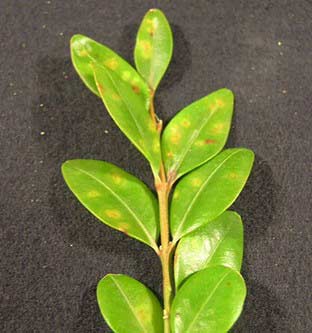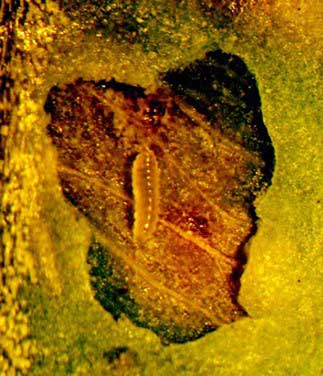Arkansas Plant Health Clinic Disease Notes
Contact
Plant Diagnostician
Phone: (479) 575-2727
Email: ssmith@uada.edu
Jason Pavel
Diagnostician
Phone: (479) 575-7257
Email: jpavel@uada.edu
University of Arkansas System Division of Agriculture
Cralley Warren Building
Room 16
2601 N. Young Ave.
Fayetteville, AR 72704
Boxwood Leafminer
by Sherrie Smith and Jason Pavel - April 6, 2023
Plant Health Clinic Disease Note Issue 7

The Clinic received the first sample of Boxwood Leafminer this season. The Boxwood Leafminer, Monarthropalpus flavus, is a common pest of boxwood.
The adult Leafminer is a small fly accidentally introduced from Europe. The fly prefers American boxwood, but also attacks Japanese and English boxwood.
The adult is a yellow to orange-red fly that resembles a mosquito. When boxwoods begin to show new growth in the spring, the female mates, then inserts her eggs into the underside of the leaves. The maggot hatches and feeds in the protected space between the upper and lower leaf layer.
They overwinter as partially grown larvae and emerge in the spring to begin the cycle again. One generation occurs per year.
What are the signs of a Leafminer infestation?
Signs that boxwood has Leafminers are pale yellowish blisters on the leaves along with smaller than normal leaves. Boxwoods with heavy infestations may have thin foliage and poor color.

How do I control Boxwood Leafminers?
Apply insecticides such as Sevin or Malathion in the spring when the new leaves are fully formed. Apply a second application 6-8 weeks later. Orthene may be used to control the larvae in the mines. Merit or BioAdvanced Insect Control for Trees and Shrubs may be applied in February to early April. Infested leaves may be handpicked and destroyed.
Take aways:
- Scout for inflated oval leaf spots early in the spring.
- Handpick and destroy individual infested leaves if practical.
- Apply insecticides.
Follow us on Facebook!
This work is supported by the Crop Protection and Pest Management Program [grant no. 2017-70006- 27279/project accession no. 1013890] from the USDA National Institute of Food and Agriculture.